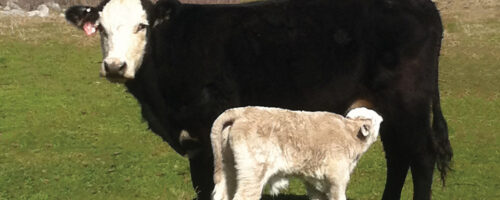Cattle producers should be on the watch for two types of poisoning during drought conditions. The potential for nitrate and prussic acid poisoning of cattle grazing or eating hay or silage is most often associated with droughts. During dry periods, livestock owners should be taking precautions with their animals, including testing forages.
Often, the first indication of a problem is one or more dead animals poisoned animals suffocate at the cellular level. Prussic acid poisoning is often acute, with death occurring within minutes of ingesting toxic levels.
Although nitrate poisoning also is often acute, other symptoms such as staggering, gasping, salivation, trembling, and rapid pulse may be observed. Although outward signs are the same for both nitrate and prussic acid poisoning, each affects cattle in a different way. Nitrate poisoning inhibits the ability of blood to transport oxygen. Mucous membranes turn dark grey-blue and blood becomes chocolate brown. Prussic acid inhibits the ability of cells to take oxygen from the blood. Mucous membranes, in this case, become bright pink and the blood is cherry red in color.
Nitrate accumulation can occur in virtually any plant with the ability to grow rapidly and use soil nitrogen efficiently. Small grains, millet, bermudagrass, and fescue are forages common to the Southern Oklahoma-North Texas area that can potentially cause nitrate poisoning problems. The most infamous, however, for both nitrate and prussic acid problems are the sorghums: forage sorghum, sorghum-sudan hybrids, sudangrass, and johnsongrass. Many weeds also can cause poisoning, including pigweed, dock, lamb’s quarters, Russian thistle, and nightshade, to list a few.
Under normal conditions, nitrate in the soil is absorbed by plant roots, transported through the stems, and converted in leaves to proteins and other substances that are useable by the animal. Nitrate typically is used by the plant about as fast as it is absorbed from the soil. Any condition hindering plant growth, however, can cause nitrate accumulation, mostly in plant stems. Nitrate poisoning occurs when this excessive nitrate is consumed and converted to nitrite faster than the animal can use it. Free nitrite in the rumen is readily absorbed into the blood stream, where it destroys the blood’s ability to absorb and carry oxygen.
Drying or ensiling forages tends to have a small effect on nitrate levels. Hays and silage from high-risk plants may remain toxic.
Nitrate poisoning is usually treated by intravenous injection of methylene blue. A veterinarian should be consulted for diagnosis and treatment of livestock.
Prussic acid is usually attached to a larger sugar molecule and is part of the normal growth process in problem plants. In this form it is not harmful to the animal. Problems occur when environmental conditions slow plant growth, causing the sugar molecules to accumulate in the plant. Accumulation is mostly in younger leaves and new growth and, again, drought is usually the cause of such poisoning.
When the plant wilts, its cells rupture and the prussic acid is freed from the sugar molecule. If consumed by grazing livestock, the free prussic acid is readily absorbed into the blood stream, where it prohibits the animal’s ability to take oxygen from the blood. Even in unwilted plants, chewing and digestion in the rumen can release toxic levels of prussic acid, meaning this can be a problem anytime.
A common treatment is intravenous injection of sodium thiosulfate and sodium nitrite, but a veterinarian should be contacted for diagnosis and treatment.
Many other conditions adversely affecting the normal growing functions of a plant can cause accumulation of nitrate and prussic acid, such as prolonged cloudiness, soil acidity, abnormally high or low temperature (especially sudden changes in temperature), herbicide treatments, and low soil phosphorous. Proper curing or ensiling of forages containing high levels of prussic acid greatly reduces or eliminates the danger because free prussic acid volatilizes fairly quickly after it is released.



Comment